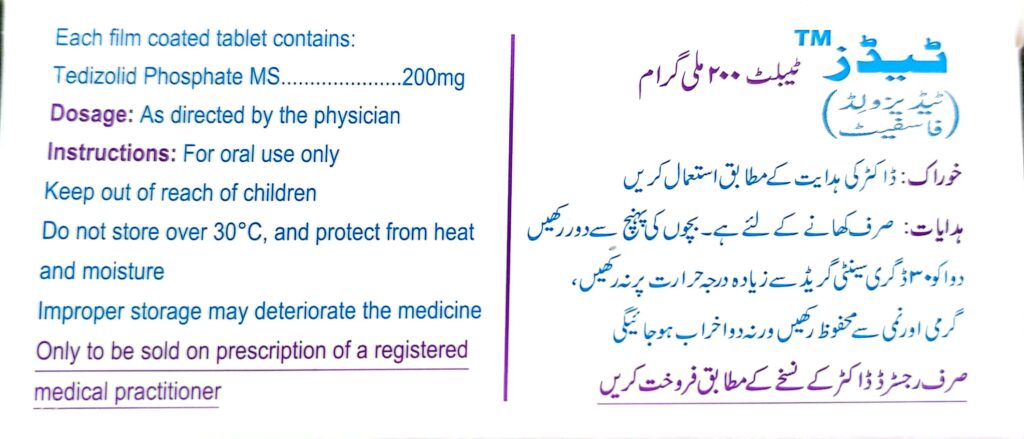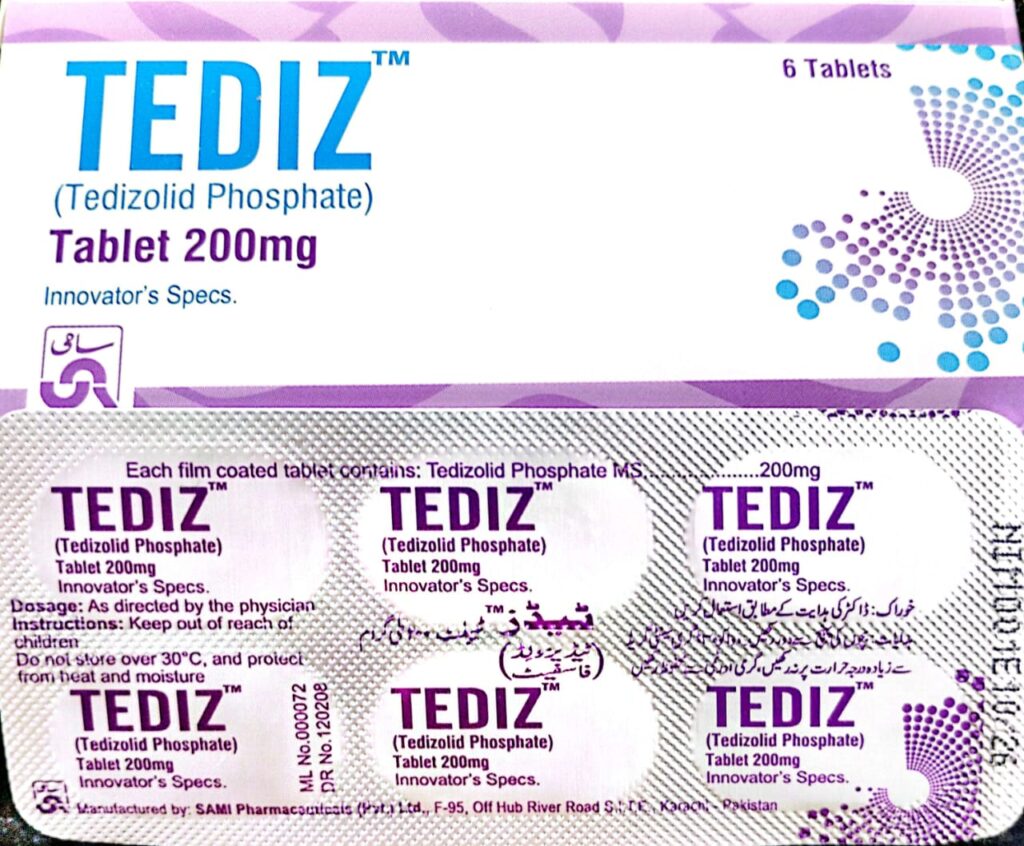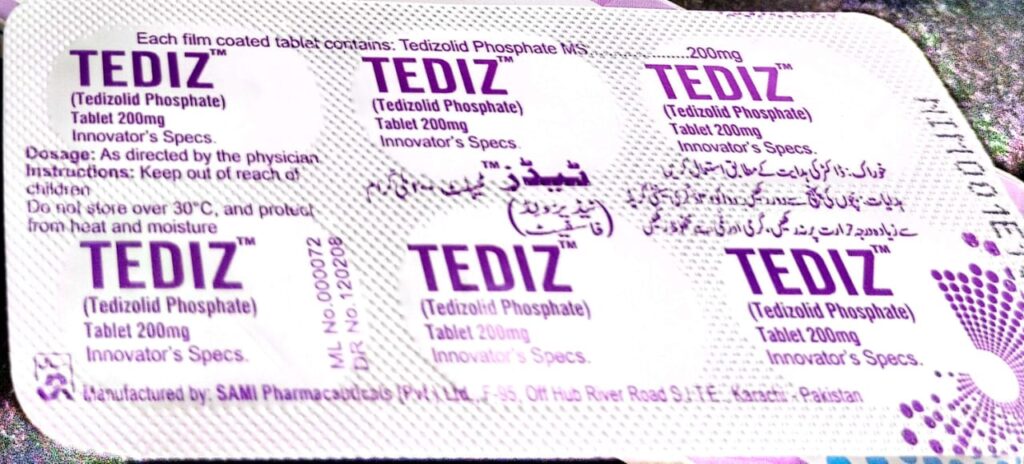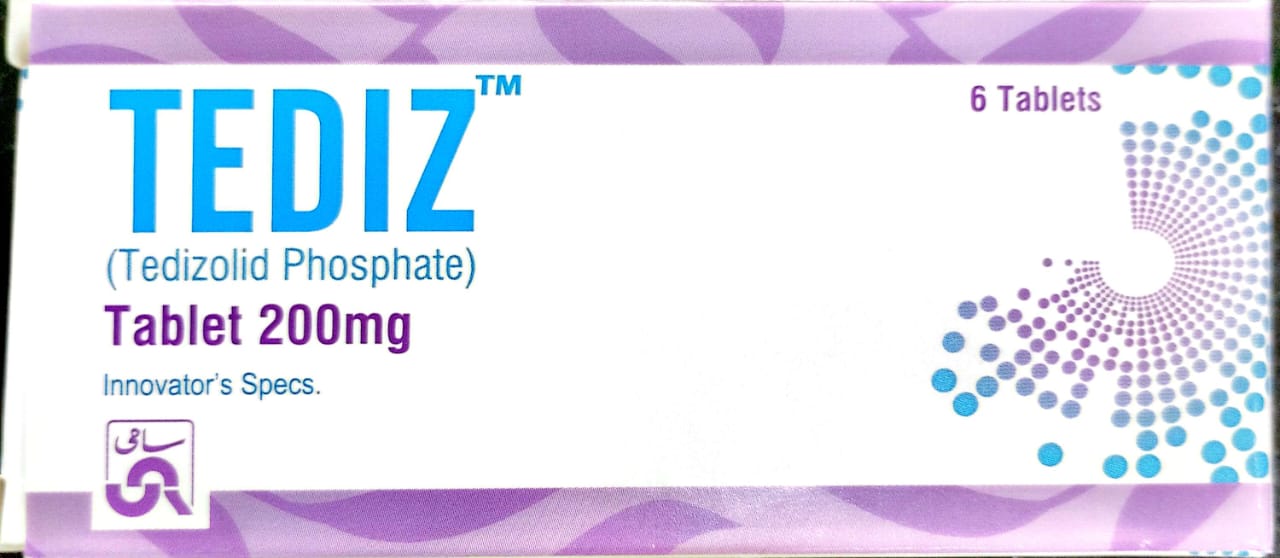TEDIZ Tablet
(Tedizolid Phosphate)
QUALITATIVE AND QUANTITATIVE COMPOSITION
TEDIZTM Tablet . . . . . . . 200mg
Each film coated tablet contains: Tedizolid Phosphate MS…200mg
PHARMACEUTICAL FORM
Film-coated tablet.
CLINICAL PARTICULARS
THERAPEUTIC INDICATIONS
TEDIZ is indicated for the treatment of acute bacterial skin and skin structure infections (ABSSSI) in adults and adolescents 12 years of age and older. Consideration should be given to official guidance on the appropriate use of antibacterial agents.
POSOLOGY AND METHOD OF ADMINISTRATION
Posology
TEDIZ tablets may be used as initial therapy. Patients who commence treatment on the parenteral formulation may be switched to the oral presentation when clinically indicated.
Recommended dose and duration
The recommended dosage for adults and adolescents 12 years of age and older is 200mg once daily for 6 days. The safety and efficacy of tedizolid phosphate when administered for periods longer than 6 days have not been established.
Missed dose
If a dose is missed, it should be taken as soon as possible anytime up to 8 hours prior to the next scheduled dose. If less than 8 hours remains before the next dose, then the patient should wait until the next scheduled dose. Patients should not take a double dose to compensate for a missed dose.
Elderly (265 years)
No dosage adjustment is required. The clinical experience in patients ≥75 years is limited.
Hepatic impairment
No dosage adjustment is required.
Renal impairment: No dosage adjustment is required.
Paediatric population
The safety and efficacy of tedizolid phosphate in children below 12 years of age have not yet been established. No recommendation on a posology for children below 12 years of age can be made.
Method of administration
For oral use. The film-coated tablets can be taken with or without food. The time to tedizolid peak concentration with oral administration under fasting conditions is 6 hours faster than when administered with a high-fat, high-calorie meal. If a rapid antibiotic effect is needed, the intravenous administration should be considered.

CONTRAINDICATIONS
Hypersensitivity to the active substance.
SPECIAL WARNINGS AND PRECAUTIONS FOR USE
Patients with neutropenia
The safety and efficacy of tedizolid phosphate in patients with neutropenia (neutrophil counts <1,000 cells/mm3) have not been investigated. In an animal model of infection, the antibacterial activity of tedizolid was reduced in the absence of granulocytes. The clinical relevance of this finding is unknown. Alternative therapies should be considered when treating patients with neutropenia and ABSSSI.
Mitochondrial dysfunction
Tedizolid inhibits mitochondrial protein synthesis. Adverse reactions such as lactic acidosis, anaemia and neuropathy (optic and peripheral) may occur as a result of this inhibition. These events have been observed with another member of the oxazolidinone class when administered over a duration exceeding that recommended for tedizolid phosphate.
Myelosuppression
Thrombocytopenia, decreased haemoglobin and decreased neutrophils have been observed during treatment with tedizolid phosphate. Anaemia, leucopenia and pancytopenia have been reported in patients treated with another member of the oxazolidinone class and the risk of these effects appeared to be related to the duration of treatment. Most cases of thrombocytopenia occurred with treatment lasting longer than the recommended duration. There may be an association with thrombocytopenia in patients with renal insufficiency. Patients who develop myelosuppression should be monitored and the benefit-risk should be re-evaluated. If treatment is continued, close monitoring of blood counts and appropriate management strategies should be implemented.
Peripheral neuropathy and optic nerve disorders: Peripheral neuropathy, as well as optic neuropathy sometimes progressing to loss of vision, have been reported in patients treated with another member of the oxazolidinone class with treatment durations exceeding that recommended for tedizolid phosphate. Neuropathy (optic and peripheral) has not been reported in patients treated with tedizolid phosphate at the recommended treatment duration of 6 days. All patients should be advised to report symptoms of visual impairment, such as changes in visual acuity, changes in color vision, blurred vision, or visual field defect. In such cases, prompt evaluation is recommended with referral to an ophthalmologist as necessary.
Lactic acidosis
Lactic acidosis has been reported with the use of another member of the oxazolidinone class. Lactic acidosis has not been reported in patients treated with tedizolid phosphate at the recommended treatment duration of 6 days.
Hypersensitivity reactions
Tedizolid phosphate should be administered with caution in patients known to be hypersensitive to other oxazolidinones since cross-hypersensitivity may occur.
Clostridiel
GRADY &

cross-hypersensitivity may occur
Clostridioldes difficile associated diarrhoea: Clostridioides difficile associated diarrhoea (CDAD) has been reported for tedizolid phosphate. CDAD may range in severity from mild diarrhoea to fatal colitis. Treatment with antibacterial agents alters the normal flora of the colon and may permit overgrowth of C. difficile. CDAD must be considered in all patients who present with severe diarrhoea following antibiotic use. Careful medical history is necessary since CDAD has been reported to occur over two months after the administration of antibacterial agents. If CDAD is suspected or confirmed, tedizolid phosphate and, if possible, other antibacterial agents not directed against C. difficile should be discontinued and adequate therapeutic measures should be initiated immediately. Appropriate supportive measures, antibiotic treatment of C. difficile, and surgical evaluation should be considered. Medicinal products inhibiting peristalsis are contraindicated in this situation.
Monoamine oxidase inhibition: Tedizolid is a reversible, non-selective inhibitor of monoamine oxidase (MAO) in vitro.
Serotonin syndrome: Spontaneous reports of serotonin syndrome associated with the co-administration of oxazolidinones, including tedizolid phosphate, together with serotonergic agents (such as antidepressants and opioids) have been reported. Caution should be exercised when tedizolid is used with these medicinal products. Patients should be closely observed for signs and symptoms of serotonin syndrome such as cognitive dysfunction, hyperpyravia, hyperreflexia and incoordination. If signs or symptoms occur, physicians should consider discontinuing either one or both agents..
Non-susceptible microorganisms:
Prescribing tedizolid phosphate in the absence of a proven or strongly suspected bacterial infection increases the risk of the development of drug-resistant bacteria. Tedizolid is generally not active against Gram-negative bacteria.
Limitations of the clinical data
The safety and efficacy of tedizolid phosphate when administered for periods longer than 6 days have not been established. In ABSSSI, the types of infections treated were confined to cellulitis/erysipelas or major cutaneous abscesses, and wound infections only. Other types of skin infections have not been studied. There is limited experience with tedizolid phosphate in the treatment of patients with concomitant acute bacterial skin and skin structure infections and secondary bacteraemia and no experience in the treatment of ABSSSI with severe sepsis or septic shock. Controlled clinical studies did not include patients with neutropenia (neutrophil counts <1,000 cells/mm3) or severely immunocompromised patients.

INTERACTION WITH OTHER MEDICINAL PRODUCTS AND OTHER FORM OF INTERACTIONS
Pharmacokinetic interactions
In a clinical study comparing the single dose (10mg) pharmacokinetics of rosuvastatin (Breast Cancer Resistant Protein [BCRP) substrate) alone or in combination with tedizolid phosphate (once-daily 200mg oral dose), rosuvastatin AUC and C increased by approximately 70% and 55%, respectively, when coadministered with tedizolid phosphate. Therefore, orally administered tedizolid phosphate can result in inhibition of BCRP at the intestinal level. If possible, an interruption of the coadministered BCRP substrate medicinal product (such as imatinib, lapatinib, methotrexate, pitavastatin, rosuvastatin, sulfasalazine, and topotecan) should be considered during the 6 days of treatment with oral tedizolid phosphate. In a clinical study comparing the single dose (2mg) pharmacokinetics of midazolam (CYP3A4 substrate) alone or in combination with tedizolid phosphate (once-daily 200mg oral dose for 10 days), midazolam AUC and C when co-administered with tedizolid phosphate were 81% and 83% of midazolam AUC and Cm wheh administered alone, respectively. This effect is not clinically meaningful, and no dose adjustment for co-administered CYP3A4 substrates is necessary during tedizolid phosphate treatment.
Pharmacodynamic Interactions
Monoamine oxidase inhibition: Tedizolid is a reversible inhibitor of monoamine oxidase (MAO) in vitro; however, no interaction is anticipated when comparing the ICs for MAO-A inhibition and the anticipated plasma exposures in man. Drug interaction studies to determine effects of 200mg oral tedizolid phosphate at steady state on pseudoephedrine and tyramine pressor effects were conducted in healthy volunteers. No meaningful changes in blood pressure or heart rate with pseudoephedrine were observed in the healthy volunteers, and no clinically relevant increase in tyramine sensitivity was observed. Potential serotonergic interactions: The potential for serotonergic interactions has not been studied in either patients or healthy volunteers. Post-marketing experience: there have been reports of patients experiencing serotonin syndrome while taking tedizolid and serotonergic agents (antidepressants, opioids) which resolved on discontinuation of one or both medications. FERTILITY, PREGNANCY AND LACTATION
Fertility
The effects of tedizolid phosphate on fertility in humans have not been studied. Animal studies with tedizolid phosphate do not indicate harmful effects with respect to fertility. Pregnancy: There are no data from the use of tedizolid phosphate in pregnant women. As a precautionary measure, it is preferable to avoid the use of tedizolid phosphate
during pregnancy.
Breast-feeding
It is unknown whether tedizolid phosphate or its metabolites are excreted in human milk. Tedizolid is excreted in the breast milk of rats. A risk to the breast-feeding infant cannot be excluded. A decision must be made whether to discontinue breast-feeding or to discontinue/abstain from tedizolid phosphate therapy taking into account the benefit of breast-feeding for the child and the benefit of therapy for the woman.
EFFECTS ON ABILITY TO DRIVE AND USE MACHINES
Tedizolid Phosphate may have a minor influence on the ability to drive and use machines as it may cause dizziness, fatigue or, uncommonly, somnolence.
UNDESIRABLE EFFECTS
Adverse reactions are classified by preferred term and System Organ Class, and by frequency. Frequencies are defined as: very common (21/10); common (21/100 to <1/10); uncommon (21/1,000 to <1/100), rare (21/10,000 to <1/1,000); very rare (<1/10,000), not known (cannot be estimated from the available data). Infections and infestations: Uncommon: Vulvovaginal mycotic infection, fungal infection, vulvovaginal candidiasis, abscess, Clostridioides difficile colitis, dermatophytosis, oral candidiasis, respiratory tract infection. Blood and lymphatic system disorders:
Uncommon
Lymphadenopathy. Not known: Thrombocytopenia”. Immune system: Uncommon: Drug hypersensitivity. Metabolism and nutrition disorders: Uncommon: Dehydration, diabetes mellitus inadequate control, hyperkalaemia.
Psychiatric disorders
Uncommon: Insomnia, sleep disorder, anxiety, nightmare. Nervous system disorders: Common: Dizziness, headache. Uncommon: Somnolence, dysgeusia, tremor, paraesthesia, hypoaesthesia. Eye disorders: Uncommon: Vision blurred, vitreous floaters Cardiac disorders: Uncommon: Bradycardia. Vascular disorders: Uncommon: Flushing, hot flush. Respiratory, thoracic and mediastinal disorders: Uncommon: Cough, nasal dryness, pulmonary congestion. Gastrointestinal disorders: Common: Diarrhoea, nausea, vomiting. Uncommon: Abdominal pain, constipation, abdominal discomfort, dry mouth, dyspepsia, abdominal pain upper, flatulence, gastrooesophageal reflux disease, haematochezia, retching Skin and subcutaneous tissue disorders: Common: Pruritus generalised.
Uncommon: Hyperhidrosis, pruritus, rash, urticaria, alopecia, rash erythematous, rash generalised, acne, pruritus allergic, rash maculo-papular, rash papular, rash pruritic Musculoskeletal and connective tissue disorders: Uncommon: Arthralgia, muscle spasms, back pain, limb discomfort, neck pain. Renal and Urinary disorders: Uncommon: Urine odour abnormal. Reproductive system and breast disorders: Uncommon: Vulvovaginal pruritus. General disorders and administration site conditions: Common: Fatigue. Uncommon: Chills, imitability, pyrexia, peripheral oedema. Investigations: Uncommon: Grip strength decreased, transaminases increased, white blood cell count decreased. Based on post-marketing reports.
Since these reactions are reported voluntarily from a population of uncertain size, it is not possible to reliably estimate their frequency which is therefore categorised as not known.
OVERDOSE
In the event of overdose, Tedizolid Phosphate should be discontinued and general supportive treatment given. Haemodialysis does not result in meaningful removal of tedizolid from systemic circulation. The highest single dose administered in clinical studies was 1,200mg. All adverse reactions at this dose level were mild or moderate in severity.
PHARMACOLOGICAL PROPERTIES PHARMACODYNAMIC PROPERTIES
Pharmacotherapeutic group: Antibacterials for systemic use, other antibacterials, ATC code: J01XXX11 Mechanism of action: Tedizolid phosphate is an oxazolidinone phosphate prodrug. The antibacterial activity of ledizolid is mediated by binding to the 505 subunit of the bacterial ribosome resulting in inhibition of protein synthesis. Tedizolid is primarily active against Gram-positive bacteria. Tedizolid is bacteriostatic against enterococci, staphylococci, and streptococci in vitro.
PHARMACOKINETICS:
Oral and intravenous tedizolid phosphate is a prodrug that is rapidly converted by phosphatases to tedizolid, the microbiologically active moiety. Only the pharmacokinetic profile of tedizolid is discussed in this section. Absorption: The absolute bioavailability of tedizolid is above 90%. Peak plasma tedizolid concentrations are achieved within approximately 3 hours after dosing after oral administration of tedizolid phosphate under fasted conditions. Peak concentrations (C) of tedizolid are reduced by approximately 26% and delayed by 6 hours when tedizolid phosphate is administered after a high-fat meal relative to fasted. Distribution:
The average binding of tedizolid to human plasma proteins is approximately 70-90%. The mean steady state volume of distribution of tedizolid in healthy adults (n=8) following a single intravenous dose of tedizolid phosphate 200mg ranged from 67 to 80 L Metabolism: Tedizolid phosphate is converted by endogenous plasma and tissue phosphatases to the microbiologically active moiety, tedizolid. Other than tedizolid, which accounts for approximately 95% of the total radiocarbon AUC in plasma, there are no other significant circulating metabolites. When incubated with pooled human liver microsomes, tedizolid was stable suggesting that tedizolid is not a substrate for hepatic CYP450 enzymes. Multiple sulfotransferase (SULT) enzymes (SULT1A1, SULT1A2, and SULT2A1) are involved in the biotransformation of tedizolid, to form an inactive and non-circulating sulphate conjugate found in the excreta.
Elimination: Tedizolid is eliminated in excreta, primarily as a non-circulating sulphate conjugate. Following single oral administration of 14C-labeled tedizolid phosphate under fasted conditions, the majority of elimination occurred via the liver with 81.5% of the radioactive dose recovered in faeces and 18% in urine, with most of the elimination (>85% ) occurring within 96 hours. Less than 3% of tedizolid phosphate administered dose is excreted as active tedizolid. The elimination half-life of tedizolid is approximately 12 hours and the intravenous clearance is 6-7L/h.
PRECLINICAL SAFETY DATA
Long-term carcinogenicity studies have not been conducted with tedizolid phosphate. Repeated oral and intravenous dosing of tedizolid phosphate in rats in 1-month and 3-month toxicology studies produced dose- and time-dependent bone marrow hypocellularity (myeloid, erythroid, and megakaryocyte), with associated reduction in circulating RBCS, WBCs, and platelets. These effects showed evidence of reversibility and occurred at plasma tedizolid exposure levels (AUC) 26-fold greater than the plasma exposure associated with the human therapeutic dose. In a 1-month immunotoxicology study in rats, repeated oral dosing of tedizolid phosphate was shown to significantly reduce splenic B cells and T cells and reduce plasma IgG titres. These effects occurred at plasma tedizolid exposure levels (AUC) 23-fold greater than the expected human plasma exposure associated with the therapeutic dose.
A special neuropathology study was conducted in pigmented Long Evans rats administered tedizolid phosphate daily for up to 9 months. This study used sensitive morphologic evaluation of perfusion-fixed peripheral and central nervous system tissue. No evidence of neurotoxicity, including neurobehavioral changes or optic or peripheral neuropathy, was associated with tedizolid after 1, 3, 6 or 9 months of oral administration up to doses with plasma exposure levels (AUC) up to 8-fold greater than the expected human plasma exposure at the oral therapeutic dose. Tedizolid phosphate was negative for genotoxicity in all in vitro assays (bacterial reverse mutation (Ames). Chinese hamster lung (CHL) cell chromosomal aberration) and in all in vivo tests (mouse bone marrow micronucleus, rat liver unscheduled DNA synthesis). Tedizolid, generated from tedizolid phosphate after metabolic activation (in vitro and in vivo), was also tested for genotoxicity. Tedizolid was positive in an in vitro CHL cell chromosomal aberration assay, but negative for genotoxicity in other in vitro assays (Ames, mouse lymphoma mutagenicity) and in vivo in a mouse bone marrow micronucleus assay. Tedizolid phosphate had no adverse effects on the fertility or reproductive performance of male rats, including spermatogenesis, at oral doses up to the maximum tested dose of 50mg/kg/day, or adult female rats at oral doses up to the maximum tested dose of 15mg/kg/day. These dose levels equate to exposure margins of ≥ 5.3-fold for males and 2 4.2-fold for females relative to tedizolid plasma AUCO-24 levels at the human oral therapeutic dose. Embryo-foetal development studies in mice and rats showed no evidence of a teratogenic effect at exposure levels 4-fold and 6-fold, respectively, those expected in humans.
In embryo-foetal studies, tedizolid phosphate was shown to produce foetal developmental toxicities in mice and rats. Foetal developmental effects occurring in mice in the absence of maternal toxicity included reduced foetal weights and an increased incidence of costal cartilage fusion (an exacerbation of the normal genetic predisposition to sternal variations in the CD-1 strain of mice) at the high dose of 25mg/kg/day (4-fold the estimated human exposure level based on AUCs). In rats, decreased foetal weights and increased skeletal variations including reduced ossification of the stemabrae, vertebrae, and skull were observed at the high dose of 15mg/kg/day (6-fold the estimated human exposure based on AUCs) and were associated with materal toxicity (reduced maternal body weights).
The no observed adverse effect levels (NOAELs) for foetal toxicity in mice (5mg/kg/day) as well as maternal and foetal toxicity in rats (2.5mg/kg/day) were associated with tedizolid plasma area under the curve (AUC) values approximately equivalent to the tedizolid AUC value associated with the oral human therapeutic dose. Tedizolid is excreted into the milk of lactating rats and the concentrations observed were similar to those in matemal plasma.
